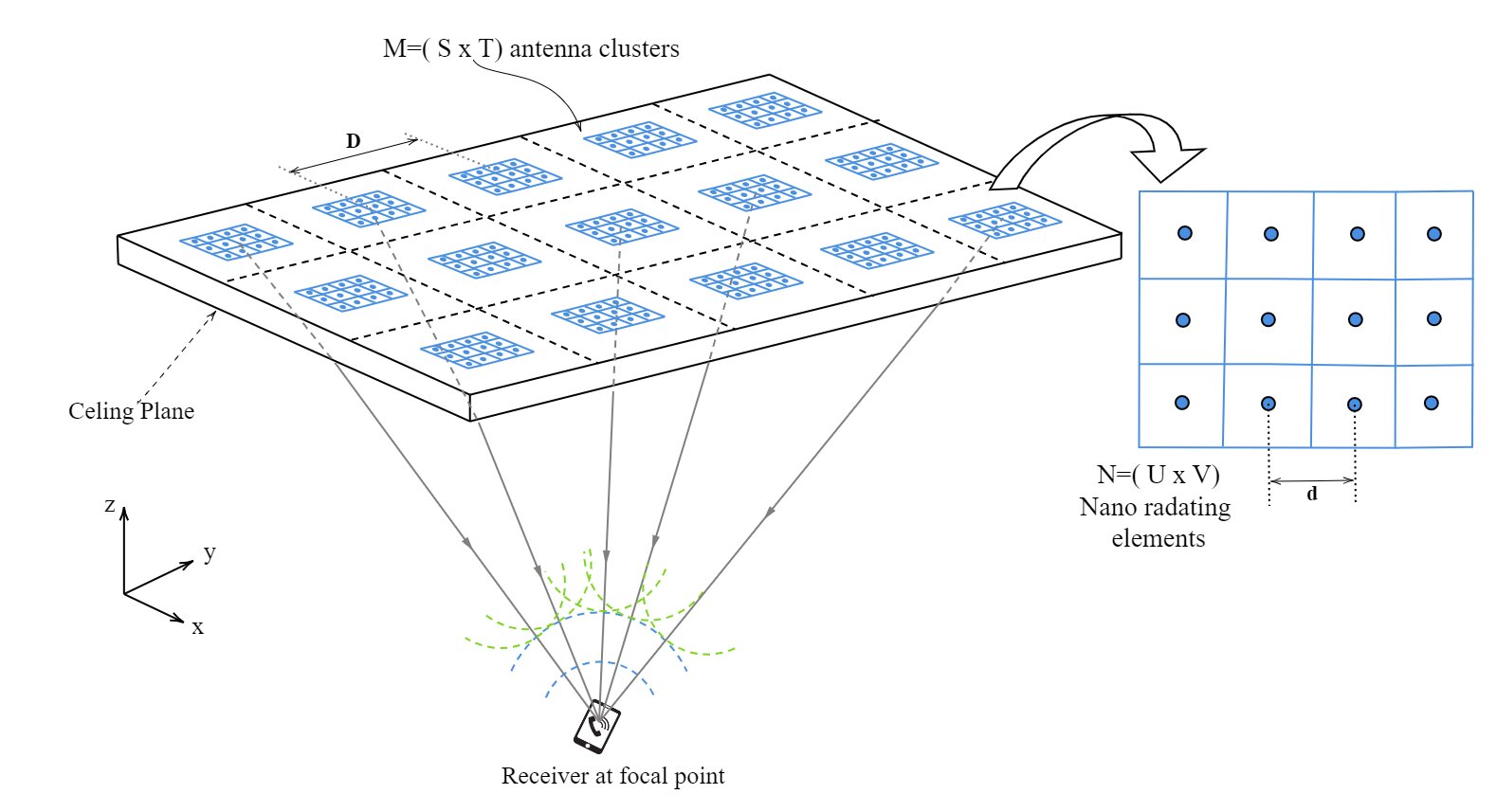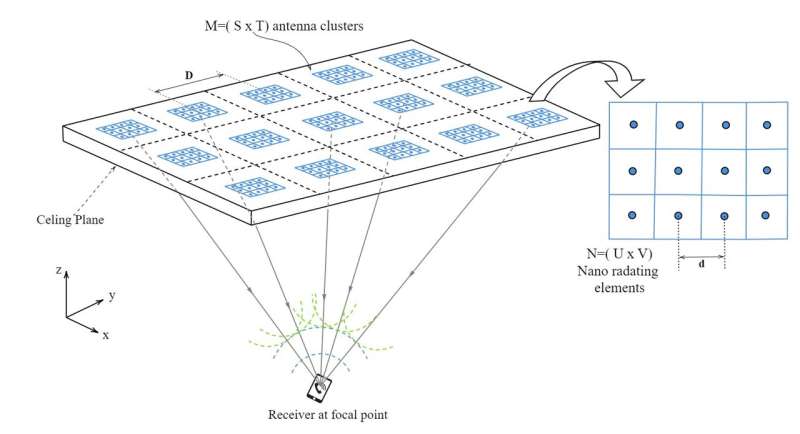

Imagine a future where indoor wireless communication systems handle skyrocketing data demands and do so with unmatched reliability and speed. Traditional radio frequency (RF) technologies like Wi-Fi and Bluetooth are beginning to struggle, plagued by limited bandwidth and increasing signal congestion.
A new solution is emerging: Optical Wireless Communication (OWC) to meet the ever-growing need for faster, more dependable communication. This is where our research steps in.
By harnessing infrared (IR) technology, we have developed an advanced system that delivers robust, interference-free signal transmission. Our work introduces a transformative approach that enhances performance and addresses some of the biggest challenges conventional RF systems face.
Our research is published in the IEEE Journal of Lightwave Technology .
Phased arrays within phased arrays: Unmatched precision
At the heart of our innovation is a revolutionary concept—the “phased array within a phased array”—which parallels the quantum superposition principle in its technical execution. Just as quantum superposition allows a particle to exist in a combination of states, with its behavior determined by the state it assumes at a given time, our system operates through arrays of smaller, complex optical antennas nested within larger arrays.
These antennas are meticulously aligned on a flat surface, and their collective behavior creates a synergistic effect that amplifies and sharpens the IR signal with unprecedented precision.
Instead of relying on a single transmitter that is prone to interference or obstacles obstructing the line of sight, our system utilizes multiple clusters of transmitting elements. This redundancy, akin to the overlapping quantum states in superposition, ensures that the signal retains clarity and reliability, even in complex environments.
What distinguishes our approach is the use of dual transmission wavelengths, which optimizes both signal focus and stability. Even when the spacing between clusters is larger, this multi-cluster configuration allows for superior beam accuracy and significantly reduces the risk of signal fade.
Ant colony optimization (ACO): A greener, more intelligent network
Beyond signal performance, energy efficiency is a central feature of our system. To optimize resource usage, we employ an Ant Colony Optimization (ACO) algorithm. Inspired by ants searching for food, this algorithm intelligently directs the system to activate only the clusters necessary for transmission, like turning off unnecessary lights to conserve power.
Traditional wireless systems tend to waste energy by powering the entire network continuously, even when not needed. Our ACO-driven approach drastically reduces this energy consumption by selectively deactivating idle clusters, slashing operational costs and minimizing environmental impact. This is crucial as the world shifts toward greener, more sustainable technologies.
Impact on next-generation wireless networks
Our research opens the door to new possibilities for optical wireless networks, laying the groundwork for future advancements in communications technology. From health care environments, where reliable and secure communication is critical, to industrial and office spaces, the potential applications of this system are vast.
Importantly, our phased array design is not limited to infrared wavelengths. Our developed principles can be adapted for other wavelengths, offering versatility and scalability as the technology evolves.
This is about more than just achieving faster speeds or better performance. It is about reshaping how we connect and communicate, enabling smoother, more efficient, and more sustainable wireless networks for the future.
This story is part of Science X Dialog, where researchers can report findings from their published research articles. Visit this page for information about Science X Dialog and how to participate.
More information:
Sharadhi Gunathilake et al, Improving Transmission Efficiency in Optical Wireless Networks with IR Radiative Element Clusters and Phased Array Apertures, Journal of Lightwave Technology (2024). DOI: 10.1109/JLT.2024.3462754
Bios:
Sharadhi Gunathilake earned her B.Sc. in electronic and telecommunication engineering (with first-class honors) from University of Moratuwa, Sri Lanka in 2017.Following five years of experience in the telecommunications industry, she is currently a PhD candidate and a member of the Advanced Computing and Simulations Laboratory at the Department of Electrical and Computer Systems Engineering, Monash University, Australia, under the supervision of Prof. Malin Premaratne. Her research interests include optical wireless communication and phased array beamforming algorithm design.
Malin Premaratne earned several degrees from the University of Melbourne, including a B.Sc. in mathematics, a B.E. in electrical and electronics engineering (with first-class honors), and a PhD in 1995, 1995, and 1998, respectively. He has been leading the research program in high-performance computing applications to complex systems simulations at the Advanced Computing and Simulation Laboratory, Monash University, Clayton, since 2004, and currently serves as a Full Professor. In addition to his work at Monash University, Professor Premaratne is also a Visiting Researcher at several prestigious institutions, including the Jet-Propulsion Laboratory at Caltech, the University of Melbourne, the Australian National University, the University of California Los Angeles, the University of Rochester New York, and Oxford University. He has published more than 250 journal papers and two books and has served as an associate editor for several leading academic journals, including IEEE Photonics Technology Letters, IEEE Photonics Journal and Advances in Optics and Photonics. Professor Premaratne’s contributions to the field of optics and photonics have been recognized with numerous fellowships, including the Fellow of the Optical Society of America (FOSA), the Society of Photo-Optical Instrumentation Engineers USA (FSPIE), the Institute of Physics U.K. (FInstP), the Institution of Engineering and Technology U.K. (FIET) and The Institute of Engineers Australia (FIEAust).
Citation:
Harnessing quantum principles: Phased arrays within phased arrays for smarter, greener indoor optical wireless networks (2024, October 11)
retrieved 11 October 2024
from https://phys.org/news/2024-10-harnessing-quantum-principles-phased-arrays.html
This document is subject to copyright. Apart from any fair dealing for the purpose of private study or research, no
part may be reproduced without the written permission. The content is provided for information purposes only.